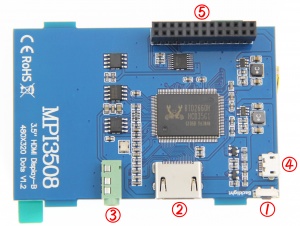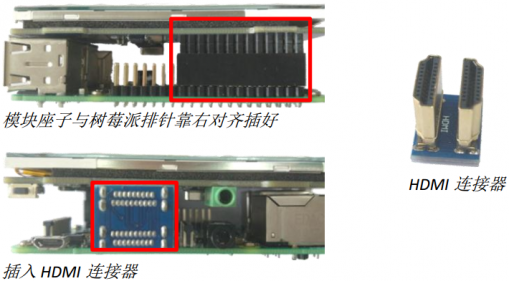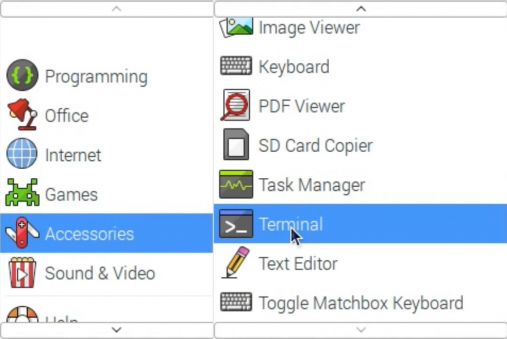Line 6:
Line 6: }}
}}
<tabber>
Description=
== <font color="blue">Product Video</font> ==
== <font color="blue">Product Video</font> ==
{{#ev:youtube|gv_qCIYgbFQ}}
{{#ev:youtube|gv_qCIYgbFQ}}
Line 214:
Line 212: [[#top|BACK TO TOP]]
[[#top|BACK TO TOP]]
|-|
FAQ=
<table class="a-r at-c roundy bgd-blue bl-white" style="margin-left: 5px; margin-bottom: 5px;"> <table style="margin-top: 10px; border-right: 20px solid transparent; border-top: 20px solid #008DE6;"><table style="margin-top: 10px; border-right: 20px solid transparent; border-top: 20px solid #008DE6;">
<tr>
<td>
<table class="roundy" style="margin-top: -30px; margin-left: -5px; margin-right: -5px; background: #008DE6;">
<tr>
<td><font color="#FFF"> <big><big>
<br />
Question: Using the Raspberry Pi image provided by the CD/net disk, cannot use the LCD normally.
</big></big></font>
</td></tr></table>
</td></tr></table>
<table style="margin-top: 10px; border-left: 20px solid transparent; border-top: 20px solid #DDD;">
<tr>
<td>
<table class="roundy mw-collapsible" style="margin-top: -30px; margin-left: -5px; margin-right: -5px; background: #DDD;">
<tr>
<td>
=== <font color="#008DE6"> <b><big>Answer:</big></b></font> ===
</td></tr>
<tr>
<td>
* Confirm that the hardware connection is correct and the contact is good.
* Determine whether TF card is normal and whether the system is started normally.
* The PWR lamp is always bright when the Raspberry Pi is started, and the ACT light is flashing.If you find both lights on,
it may be the TF card does not successfully burn the image file,or that the TF card is not in contact with the Raspberry Pi.
* Recommend using 5V 2A power adapter to power the Raspberry Pi.
* If you use a computer USB interface, you may not be able to activate the Raspberry Pi due to insufficient power supply.
</td></tr></table>
</td></tr></table><br /><table style="margin-top: 10px; border-right: 20px solid transparent; border-top: 20px solid #008DE6;">
<tr>
<td>
<table class="roundy" style="margin-top: -30px; margin-left: -5px; margin-right: -5px; background: #008DE6;">
<tr>
<td><font color="#FFF"> <big><big>Question: What is the reason for the LCD not displayed using the image provided by the Raspberry Pi official?</big></big></font>
</td></tr></table>
</td></tr></table>
<table style="margin-top: 10px; border-left: 20px solid transparent; border-top: 20px solid #DDD;">
<tr>
<td>
<table class="roundy mw-collapsible" style="margin-top: -30px; margin-left: -5px; margin-right: -5px; background: #DDD;">
<tr>
<td>
=== <font color="#008DE6"> <b><big>Answer:</big></b></font> ===
</td></tr>
<tr>
<td>
<ul><li>LCD needs to be installed driver to display correctly, please refer to "How to install the LCD driver (En)" related documentation.
</li><li>It is recommended to use the image file provided by us first to test. After the test is passed, use the image file of Raspberry Pi official and installed the driver.
</li></ul>
</td></tr></table>
</td></tr></table><br /><table style="margin-top: 10px; border-right: 20px solid transparent; border-top: 20px solid #008DE6;">
<tr>
<td>
<table class="roundy" style="margin-top: -30px; margin-left: -5px; margin-right: -5px; background: #008DE6;">
<tr>
<td><font color="#FFF"> <b><big><big>Question: How to switch back to traditional monitor for display?</big></big></b></font>
</td></tr></table>
</td></tr></table>
<table style="margin-top: 10px; border-left: 20px solid transparent; border-top: 20px solid #DDD;">
<tr>
<td>
<table class="roundy mw-collapsible" style="margin-top: -30px; margin-left: -5px; margin-right: -5px; background: #DDD;">
<tr>
<td>
=== <font color="#008DE6"><big>Answer<b>:</b></big></font> ===
</td></tr>
<tr>
<td>
<ul><li>Please refer to "How to install the LCD driver (En)" related instruction document, and use the following command:
<pre style="border: 1px dashed black;color:black">
sudo ./LCD-hdmi
</pre>
</li></ul>
</td></tr></table>
</td></tr></table><br /><table style="margin-top: 10px; border-right: 20px solid transparent; border-top: 20px solid #008DE6;">
<tr>
<td>
<table class="roundy" style="margin-top: -30px; margin-left: -5px; margin-right: -5px; background: #008DE6;">
<tr>
<td><font color="#FFF"> <big><big>Question: Why the LCD works but flickers?</big></big></font>
</td></tr></table>
</td></tr></table>
<table style="margin-top: 10px; border-left: 20px solid transparent; border-top: 20px solid #DDD;">
<tr>
<td>
<table class="roundy mw-collapsible" style="margin-top: -30px; margin-left: -5px; margin-right: -5px; background: #DDD;">
<tr>
<td>
=== <font color="#008DE6"> <b><big>Answer:</big></b></font> ===
</td></tr>
<tr>
<td>
<ul><li>This problem is likely due to insufficient power supply.
</li><li>If you are using the Raspberry Pi, please use the power supply of 5V full 2A to power the Raspberry Pi,
</li></ul>and connect the Raspberry Pi and the LCD by the short USB cable we provided.
<ul><li>If it is used as a computer monitor, do not use poor quality USB cable or extension cord connection,
</li></ul>do not receive extend the USB port to get electricity, please use the USB cable we provided.
</td></tr></table>
</td></tr></table><br /><table style="margin-top: 10px; border-right: 20px solid transparent; border-top: 20px solid #008DE6;">
<tr>
<td>
<table class="roundy" style="margin-top: -30px; margin-left: -5px; margin-right: -5px; background: #008DE6;">
<tr>
<td><font color="#FFF"> <big><big>Question: Why the Raspberry Pi unable to work properly after updating the Raspbian system?</big></big></font><font color="#EEE"><big>?</big></font>
</td></tr></table>
</td></tr></table>
<table style="margin-top: 10px; border-left: 20px solid transparent; border-top: 20px solid #DDD;">
<tr>
<td>
<table class="roundy mw-collapsible" style="margin-top: -30px; margin-left: -5px; margin-right: -5px; background: #DDD;">
<tr>
<td>
=== <font color="#008DE6"><big>Answer<b>:</b></big></font> ===
</td></tr>
<tr>
<td>
<ul><li>The update needs to be done in the following manner, otherwise the image cannot run:
<pre style="border: 1px dashed black;color:black">
sudo apt-mark hold raspberrypi-bootloader
sudo apt-get update
sudo apt-get upgrade
</pre>
</li></ul>
</td></tr></table>
</td></tr></table><br /><table style="margin-top: 10px; border-right: 20px solid transparent; border-top: 20px solid #008DE6;">
<tr>
<td>
<table class="roundy" style="margin-top: -30px; margin-left: -5px; margin-right: -5px; background: #008DE6;">
<tr>
<td><font color="#FFF"> <big><big>Question: Why the LCD is connected to the computer HDMI, but cannot be displayed normally?</big></big></font>
</td></tr></table>
</td></tr></table>
<table style="margin-top: 10px; border-left: 20px solid transparent; border-top: 20px solid #DDD;">
<tr>
<td>
<table class="roundy mw-collapsible" style="margin-top: -30px; margin-left: -5px; margin-right: -5px; background: #DDD;">
<tr>
<td>
=== <font color="#008DE6"> <b><big>Answer:</big></b></font> ===
</td></tr>
<tr>
<td>Make sure the HDMI interface of the computer can be output normally.
The computer only connects to the LCD as a display device, and does not connect to other monitors (unplug other monitors).
Connect the USB first, then the HDMI.
Try to restart your computer.
You must use the Windows operating system. <ul><li></li></ul>
</td></tr></table>
</td></tr></table><br /><table style="margin-top: 10px; border-right: 20px solid transparent; border-top: 20px solid #008DE6;">
<tr>
<td>
<table class="roundy" style="margin-top: -30px; margin-left: -5px; margin-right: -5px; background: #008DE6;">
<tr>
<td><font color="#FFF"> <big><big>Question: How to turn on the Bluetooth function on the Raspberry Pi?</big></big></font>
</td></tr></table>
</td></tr></table>
<table style="margin-top: 10px; border-left: 20px solid transparent; border-top: 20px solid #DDD;">
<tr>
<td>
<table class="roundy mw-collapsible" style="margin-top: -30px; margin-left: -5px; margin-right: -5px; background: #DDD;">
<tr>
<td>
=== <font color="#008DE6"><big><b>Anwer:</b></big></font> ===
</td></tr>
<tr>
<td>
<ul><li>Method 1: upgrade to the official latest image of the Raspberry Pi (the Bluetooth function has been turned on by default after 2016-05-27-raspbian-jessie);
</li><li>Method 2: manually turn on Bluetooth.<br />
<pre style="border: 1px dashed black;color:black">
sudo apt-get install pi-bluetooth
sudo apt-get install bluetooth bluez blueman
systemctl status bluetooth
sudo systemctl start bluetooth
sudo reboot
</pre>
</li></ul>
</td></tr></table>
</td></tr></table><br /><table style="margin-top: 10px; border-right: 20px solid transparent; border-top: 20px solid #008DE6;">
<tr>
<td>
<table class="roundy" style="margin-top: -30px; margin-left: -5px; margin-right: -5px; background: #008DE6;">
<tr>
<td><font color="#FFF"> <b><big><big>Question: Why unable to display full screen or incomplete when using 5”, 5”-B, 7”-B, or 7”-C HDMI screen?</big></big></b></font>
</td></tr></table>
</td></tr></table>
<table style="margin-top: 10px; border-left: 20px solid transparent; border-top: 20px solid #DDD;">
<tr>
<td>
<table class="roundy mw-collapsible" style="margin-top: -30px; margin-left: -5px; margin-right: -5px; background: #DDD;">
<tr>
<td>
=== <font color="#008DE6"> <b><big>Answer:</big></b></font> ===
</td></tr>
<tr>
<td>
<ul><li>Check if the HDMI is plugged in and output is normal.
</li><li>Open the config.txt file in the TF card root directory to check the HDMI configuration.
</li><li>5", 5"-B and 7"-B 800*480 should be configured as follows:<br />
<pre style="border: 1px dashed black;color:black">
hdmi_group=2
hdmi_mode=1
hdmi_mode=87
hdmi_cvt 800 480 60 6 0 0 0
</pre>
</li><li>7"-C 1024*600 should be configured as follows:<br />
<pre style="border: 1px dashed black;color:black">
hdmi_group=2
hdmi_mode=1
hdmi_mode=87
hdmi_cvt 1024 600 60 6 0 0 0
</pre>
</li></ul>
</td></tr></table>
</td></tr></table>
<br />
|-|
after-sales=
{{contact_us}}
</tabber>
Product Video Pictures
Description 3.5inch standard display, support HDMI input, refresh rate above 60FPS
Physical resolution 480x320, configurable software resolution up to 1920x1080
It is compatible with mainstream mini PC such as Raspberry Pi, BB Black, Banana Pi
It can also be used as a general-purpose HDMI display, connecting computers, TV boxes, Microsoft Xbox360, SONY PS4, Nintendo Switch and so on
Used as a Raspberry Pi display that supports Raspbian, Ubuntu, Kodi, Win10 IOT, single-touch, free drive
Work as a PC monitor, support Win7, Win8, Win10 system (No touch Function)
Support HDMI audio output,Backlight brightness can be adjusted
CE, RoHS certification Parameters Size: 3.5(inch)
SKU: MPI3508
Physical Resolution: 480×320(dots)
Software adjustable resolution: 480×320~1920×1080(dots)
Touch: Resistance Touch
Power Dissipation: 0.20A*5V (Brightness @100%) 0.15A*5V (Backlight close) Product Size: 85.5*60.6(mm)
Package Size: 143*134*51 (mm)
Rough Weight(Package containing): 142(g) Hardware Description ① Backlight button: backlight brightness adjustment button, short press backlight changes by 10%, long press 3 seconds to close backlight
② HDMI interface: HDMI signal input interface
③ Amplifier interface: HDMI audio output interface
④ USB power supply interface: provide power for ordinary display (5V 1A)
⑤ Transaction raspberry pie 26PIN base: gets power and return touch from this area when used as a raspberry pie monitor
How to use with Raspbian/Ubuntu Mate/ Kali/ Retropie System
Method 1: quick install (raspberry pi needs Internet connection)
Step 1, Install Raspbian official image Download the latest image from the official download.
Install the system according to the official tutorial steps. 1) log in the raspberry pie system with Putty connection to the user command line (initial username: PI password :raspberry)
2) execute the following command (Mouse Right-click can paste the code in Putty):
sudo rm -rf LCD-show
git clone https://github.com/goodtft/LCD-show.git
chmod -R 755 LCD-show
cd LCD-show/
sudo ./MPI3508-show
After executing the above command, the system will restart automatically, and display and touch will be OK.
Method 2: offline installation
VideoService "youku" not recognized. Step 1: install the official image of Raspbian/Ubuntu 1)Download the latest Raspbian or Ubuntu image from the official website https://www.raspberrypi.org/downloads/ 2)Format the TF card with SDFormatter, 3)Use Win32DiskImager to burn the official image to the TF card. Step 2, modify the "config.txt" After the step 1 completion of burning in the CD Driver in the folder "show-LCD.tar.gz " copy to TF-card root directory,
Open the config.txt file in TF-card root directory and add the following code to the end of the file. Save and colse TF card: hdmi_force_hotplug=1
config_hdmi_boost=7
hdmi_drive=2
hdmi_force_hotplug=1
hdmi_group=2
hdmi_mode=87
hdmi_cvt 480 320 60 6 0 0 0
Step 3: insert the SD card into the raspberry pie and connect the hardware as shown in the picture:
Step 4: power the raspberry, connect the mouse keyboard, and open the terminal terminal terminal on the raspberry pie:
Step 5. Enter the following instructions in the terminal terminal: cd /boot
cp LCD-show.tar.gz ~
cd ~
sudo tar zxvf LCD-show.tar.gz
cd LCD-show/
sudo ./MPI3508-show
How to use as PC monitor Connect the computer HDMI output signal to the LCD HDMI interface by using the HDMI cable
Connect the LCD's USB Power interface to the USB port of the device
If there are several monitors, please unplug other monitor connectors first, and use LCD as the only monitor for testing.
Note: touch function can only be used for raspberry pi.
Resource How_to_install_the_LCD_driver_V1.2 How_to_install_matchbox-keyboard How_to_calibrate_the_resistance_touch_screen-V1.2 How_to_use_Raspberry_Pi(Download,Format,Burn,SSH,PuTTy)-V1.0.pdf How_to_change_display_direction-GPIO-Resistive_Touch-V1.2 MPI3508-Quick-Start-V1.3 MPI3508-3.5inch_HDMI_Display_B_User_Manual-V1.1 Product size download:LCD-show.tar.gz If you have difficulty installing the driver, or if you still can't use the display properly after installing the driver,
Please Try our Configned images for tested.
Just need download and write the image into the TF card. DO NOT need any driver installation steps. Panasonic SDFormatter Win32DiskImager PuTTY BACK TO TOP





